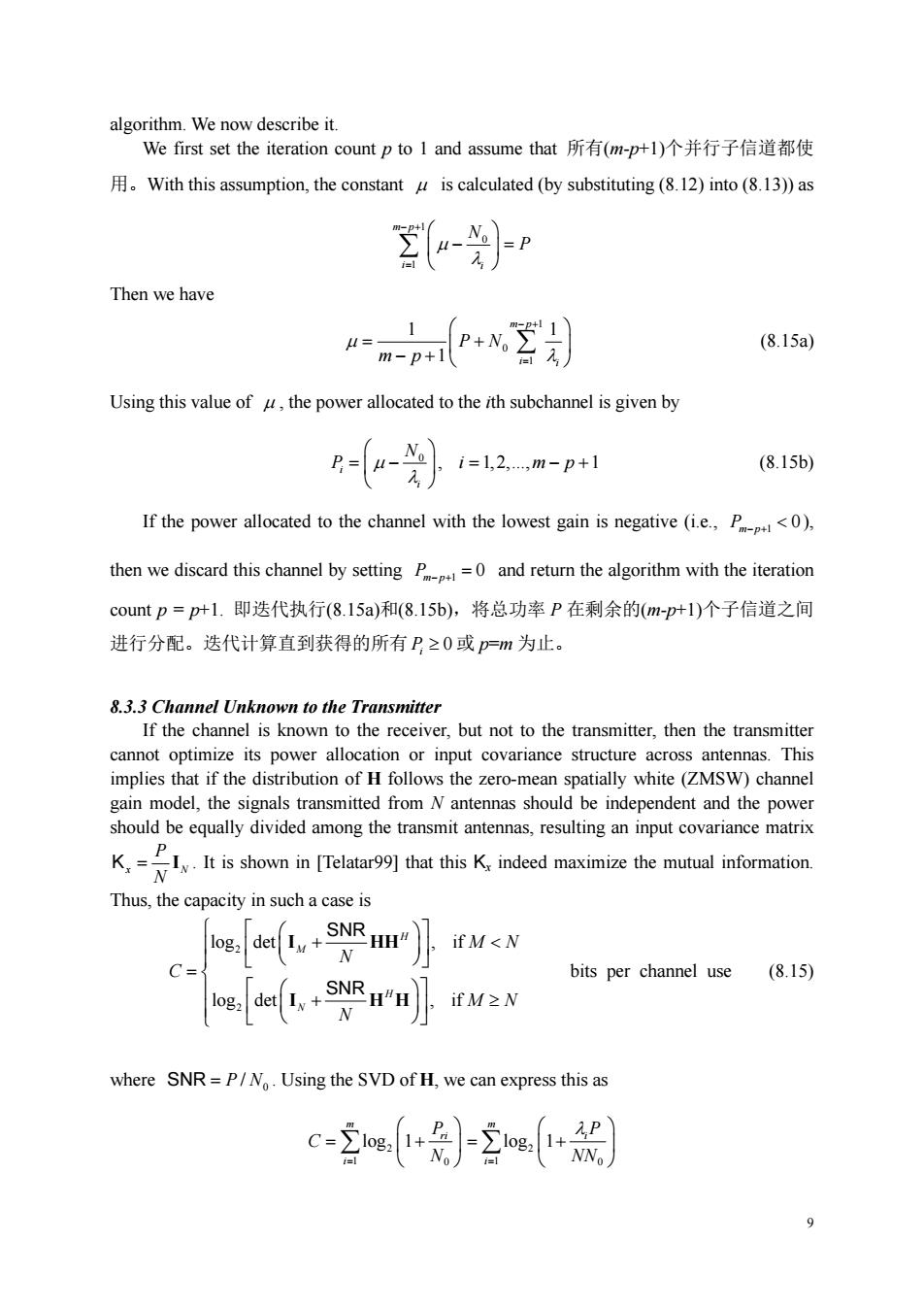正在加载图片...

algorithm.We now describe it. We first set the iteration count p to1 and assume that所有(m-p+l)个并行子信道都使 .With this assumption,the constant is calculated(by substituting(8.12)into (8.13))as -》 Then we have n-pp空别 (8.15a) Using this value of the power allocated to the ith subchannel is given by -(-艾)-12m-pl (8.15b) If the power allocated to the channel with the lowest gain is negative(i.e.,P<). then we discard this channel by setting P=0 and return the algorithm with the iteration count p=p叶1.即迭代执行(8.15a)和(8.15b),将总功率P在剩余的(m-pr1)个子信道之间 进行分配。迭代计算直到获得的所有P≥0或一m为止。 8.3.3Ch nel Unknown to the Transmitter If the channel is known to the receiver,but not to the transmitter,then the transmitter cannot optimize its power allocation or input covariance structure across antennas.This implies that if the distribution of H follows the zero-mean spatially white(ZMSW)channel gain model,the signals transmitted from N antennas should be independent and the power should be equally divided among the transmit antennas,resulting an input covariance matrix Thus,the capacity in such a case is eaL.+sRmr)tw<N C={ bits per channel use (8.15) ea,+sNum小fw≥N where SNR=P/N.Using the SVD of H,we can express this as c-2e+-2+) 9 algorithm. We now describe it. We first set the iteration count p to 1 and assume that 所有(m-p+1)个并行子信道都使 用。With this assumption, the constant is calculated (by substituting (8.12) into (8.13)) as 1 0 1 m p i i N P Then we have 1 0 1 1 1 1 m p i i P N m p (8.15a) Using this value of , the power allocated to the ith subchannel is given by 0 , 1,2,., 1 i i N P i mp (8.15b) If the power allocated to the channel with the lowest gain is negative (i.e., 1 0 P m p ), then we discard this channel by setting 1 0 P m p and return the algorithm with the iteration count p = p+1. 即迭代执行(8.15a)和(8.15b),将总功率 P 在剩余的(m-p+1)个子信道之间 进行分配。迭代计算直到获得的所有 0 Pi 或 p=m 为止。 8.3.3 Channel Unknown to the Transmitter If the channel is known to the receiver, but not to the transmitter, then the transmitter cannot optimize its power allocation or input covariance structure across antennas. This implies that if the distribution of H follows the zero-mean spatially white (ZMSW) channel gain model, the signals transmitted from N antennas should be independent and the power should be equally divided among the transmit antennas, resulting an input covariance matrix x N P N K I . It is shown in [Telatar99] that this Kx indeed maximize the mutual information. Thus, the capacity in such a case is 2 2 log det , if log det , if H M H N M N N C M N N I HH I HH SNR SNR bits per channel use (8.15) where 0 SNR P N/ . Using the SVD of H, we can express this as 2 1 0 log 1 m ri i P C N 2 1 0 log 1 m i i P NN